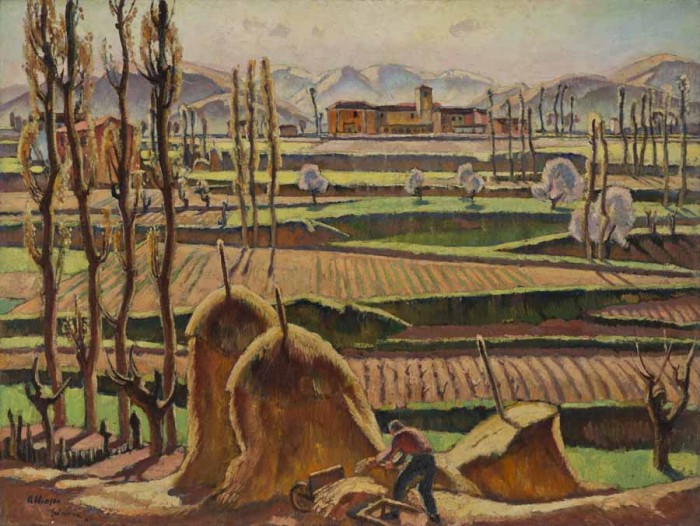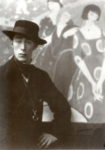
Adrian Paul Allinson
British, 1890-1959
Spring in the Abruzzi, 1930s ca.
oil on canvas
30 1/4 x 40 in.
SBMA, Gift of Mary and Will Richeson, Jr.
1997.71.6

Allinson in a photo ca. 1913.
RESEARCH PAPER
Adrian Paul Allinson was a complicated man whose skill as an artist has been overshadowed by many of his British contemporaries. His oeuvre is difficult to find, yet, we are fortunate to hold three of his works at the SBMA.
The Abruzzi is a mountainous region northeast of Rome that is bordered by the Adriatic Sea to the east and the Apennine mountains to the west. The Abruzzi is known as the greenest region in Italy, and Allinson captures the beginnings of this colorfully vivid time in his painting, “Spring in the Abruzzi”.
Allinson uses a springtime palette of yellows and greens to portray the hilly fields coming to life. He paints patches of new growth depicted by the youthful sprouts in various hues of yellow and green, depending on how the sunlight hits the earth. The green pastures are interspersed between the white flowering almond trees, whose fields zigzag between the newly planted crops in the foreground. Allinson also uses yellows and greens to show the leafing of new leaves on the tall, slender trees that grow in clusters on the left and right sides of the painting.
We can almost feel the warmth of the sunlight heating up the earth as we look at his use of yellows in the painting. Allinson uses the sharp contrast of light and dark to show the areas basking in the light and those which are sheltered from it in the shadows of the hills that run through the fields, the silhouettes of the trees that we see from our vantage point, and the mounds of haystacks in the foreground. The white, rounded tops of the almond trees are replicated in the background by the snowy tops of the Apennine mountains that peek over the large brown building in the center of the painting. The colors of green and white are representative of new life and the purity associated with spring.
Allinson uses the simplicity of geometric lines to fill and balance the composition of the painting. The vertical lines of the slender trees, the rows of plantings, and the poles providing a sturdy support for the haystacks, all lift our eyes upward to the mountains whose rounded lines move our eyes across the background of the painting. The downward rolling of the mountains leads us to the horizontal lines at the base of the mountains where we discover the geometric shapes of homes and buildings of the nearby town.
As our eyes crisscross the strong horizontal lines that outline the fields, we are led back to the man working in the foreground. His dark pants create both a diagonal and a vertical line that grounds the man to the earth he works with, and the curving of his back is reminiscent of the curve of the haystack he’s laboring over. The red of his shirt is the only red in the painting, possibly representing the worker’s love of the land and the blood, sweat, and tears he sheds preserving it. The straight legs and curving back of the man unite the two types of lines Allinson uses and fortifies the importance of the figure of the man who is in the lower center of the painting.
This pastoral scene with bright, springtime colors creates a feeling of peace and calm that is in contrast to the modern movements that were immerging in the art world; movements that were moving towards more abstract representations using geometric shapes that reflected modern technology and urban life. Perhaps the bent figure of the man working in the fields was to honor the labor of men who still worked with their hands in the peaceful countryside; man working with nature to create this beautiful springtime scene.
Adrian Allinson was born in London, January 9, 1890, and was the eldest son of doctor Thomas Allinson. Dr. Allinson promoted vegetarianism and contraception and was eventually removed from the medical registry for his unconventional views. He later founded a whole grain bread company, which still exists today. His mother was the granddaughter of a Polish rabbi who studied portrait painting in Berlin. Allinson left Wycliffe College and began studying medicine like his father, only to give it up soon afterward, and turned to studying art instead. Coming from a wealthy family, he was supported in his pursuit of the arts. Allinson enrolled in the Slade School of Fine Art and studied under Henry Tonks. It was here he met such artists as C.R.W. Nevinson, Stanley Spencer, Mark Gertier, John S. Currie, Maxwell Gordon Lightfoot, Edward Wadsworth.
After graduating in 1910, he travelled to Europe where he studied in Paris and in Munich. In 1911, he became one of the founding members of the Camden Town Group (English post-Impressionism) and later joined the London Group (formed to promote non-conservative artists). He registered as a Conscientious Objector in 1916. During World War I, he was employed for the Daily Express doing caricature drawings, and later did set designs for the Beecham Opera Company from 1914-1917. His well-known “The Café Royal” was painted at this time.
His most productive years were in the 1920s and 1930s where he travelled extensively to Italy, Switzerland, Greece, North Africa, Mallorca, Ibiza and Spain. In the late ‘30s he produced posters for London Underground and London Transportation. He worked as a government war artist in World War II and after the war he taught at the Westminster Technical Institute, exhibited at the Royal Academy and in Toronto, and continued to design stage sets. The painter, potter, sculptor, wood engraver, poster and set designer died in 1959.
Prepared for the Santa Barbara Museum of Art Docent Council by Cindy Anderson, 2020.
BIBLIOGRAPHY
http://coppice-gate.com/articles.php?id=330 Retrieved 3 January 2020.
https://cornwallartists.org/cornwall-artists/adrian-paul-allinson Retrieved 8 January 2020.
https://en.wikipedia.org/wiki/Abruzzo Retrieved 12 January 2020.
https://en.wikipedia.org/wiki/Adrian_Allinson. Retrieved 3 January 2020.
https://en.wikipedia.org/wiki/Thomas_Allinson Retrieved 12 January 2020.
https://sculpture.gla.ac.uk/view/person.php?id=msib2_1206480332 Retrieved 8 January 2020.
https://spartacus-educational.com/ARTallinson.htm Retrieved 3 January 2020.
https://www.askart.com/artist_bio/Adrian_Paul_Allinson/11011732/Adrian_Paul_Allinson.aspx Retrieved 8 January 2020.
http://www.campbell-fine-art.com/artists.php?id=357 Retrieved 8 January 2020.
https://www.revolvy.com/page/Adrian-Allinson?mt=1&reload=1&_=189330 Retrieved 12 January 2020.
http://www.westendatwar.org.uk/page_id__156_path__0p4p.aspx Retrieved 8 January 2020.
COMMENTS
Allinson was a member of the great Slade generation that included Gertler, Nevinson, Stanley Spencer and Edward Wadsworth. A prolific exhibitor with the London Group between the wars, his work received critical acclaim for its technical excellence and distinct individuality. His use of strong colour and his landscape design owed something to the work of Derain. In an introduction to his retrospective exhibition at the Fine Art Society, Terence Mullaly observed: 'At his best Adrian Allinson was both a landscape painter and a figure and still-life painter who knew exactly what he was doing. His portraits are simple and extraordinarily direct, indeed one of the tantalising things concerning them is that although today the identity of the sitters has in many cases been lost, we feel we know them.' A great traveller, he worked in Munich, Paris, North Africa, Greece, Spain, Venice and Ibiza. He was also a talented sculptor, showing many examples at the London Group and serving on the committee of the 1930 London Group Open-Air Sculpture Exhibition held on the roof gardens of Selfridges & Co. He also exhibited with the NEAC and in later years he showed at the RA. He became a distinguished stage designer to the Beecham Opera Company and for a time was a teacher at the Westminster School of Art. In 1984 the Fine Art Society organised a retrospective exhibition of his work.
Copyright © Court Gallery.
SBMA CURATORIAL LABELS
Allinson loved strong contrasts of light and shadow and throughout his life spent many months painting in the Abruzzi region of Italy and in Majorca.
- British Modernism from Whistler to WWII, 2016
